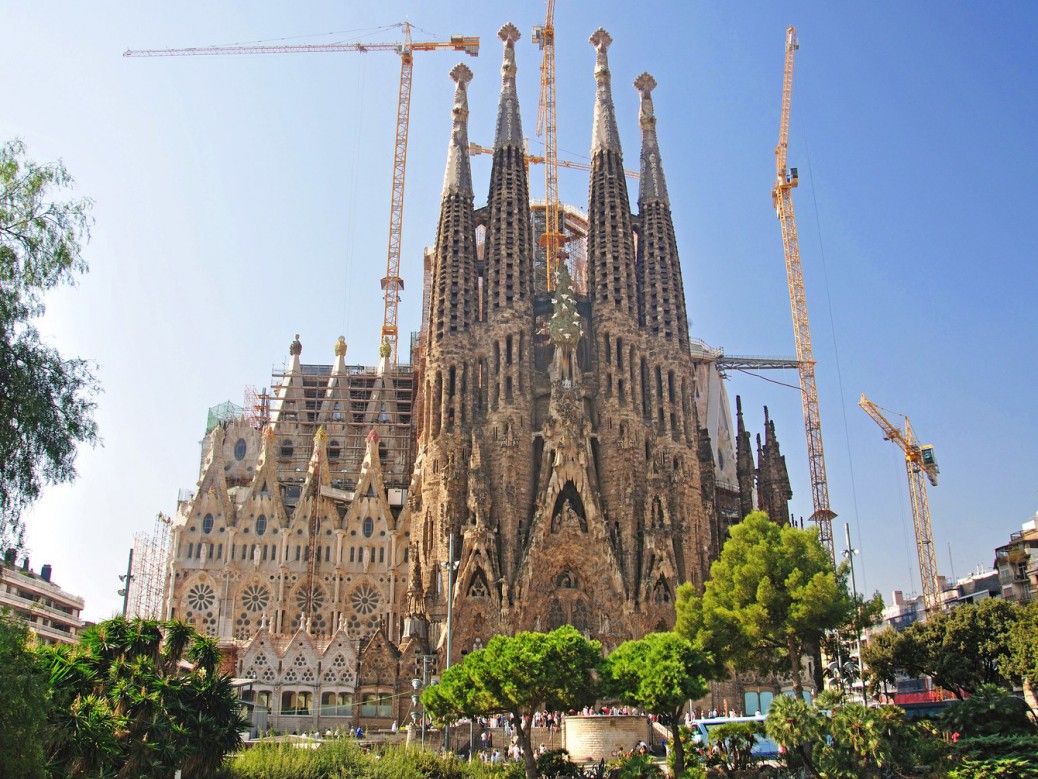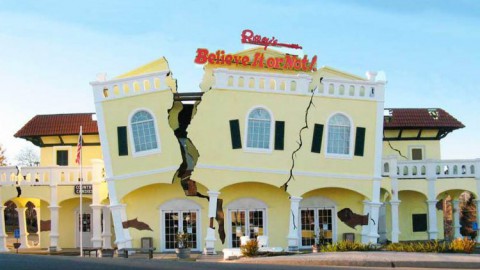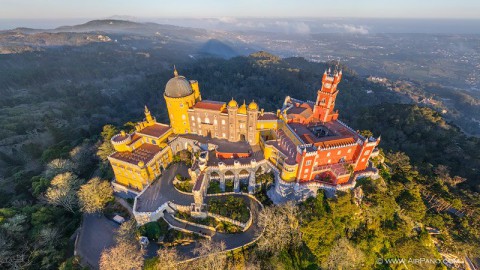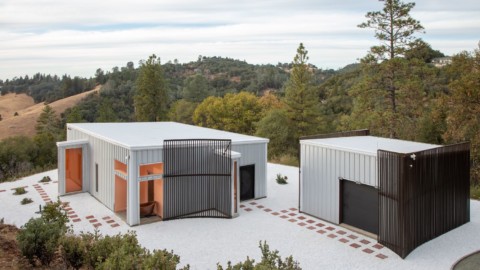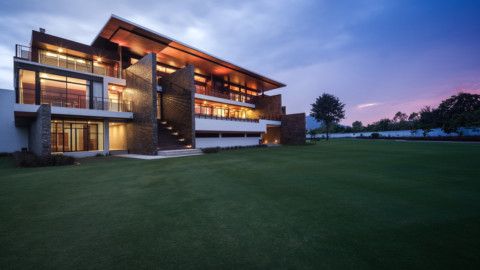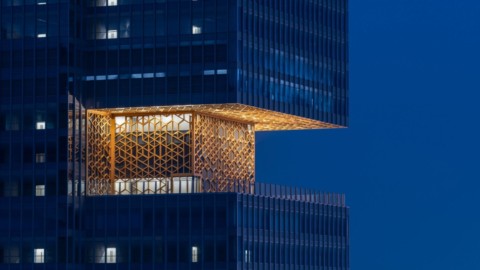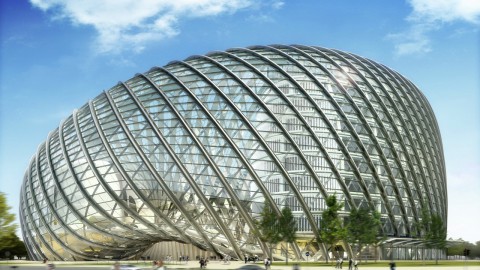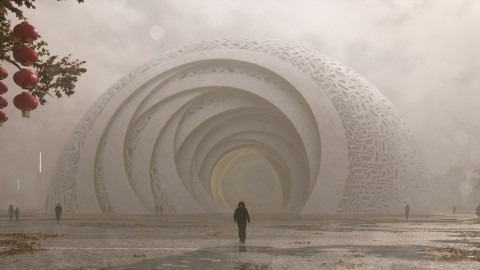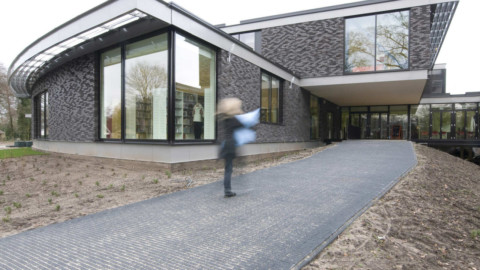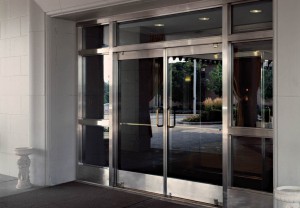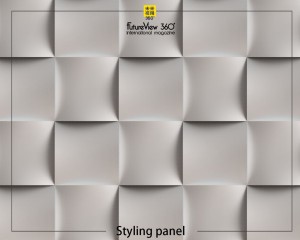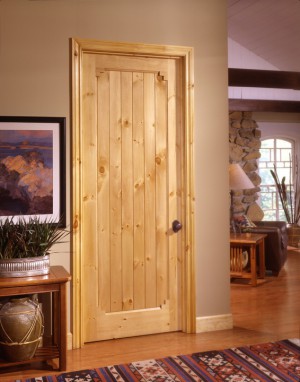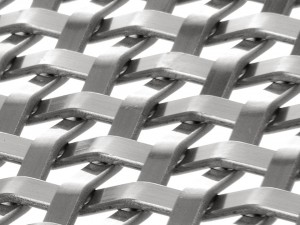Sagrada Familia 聖家堂
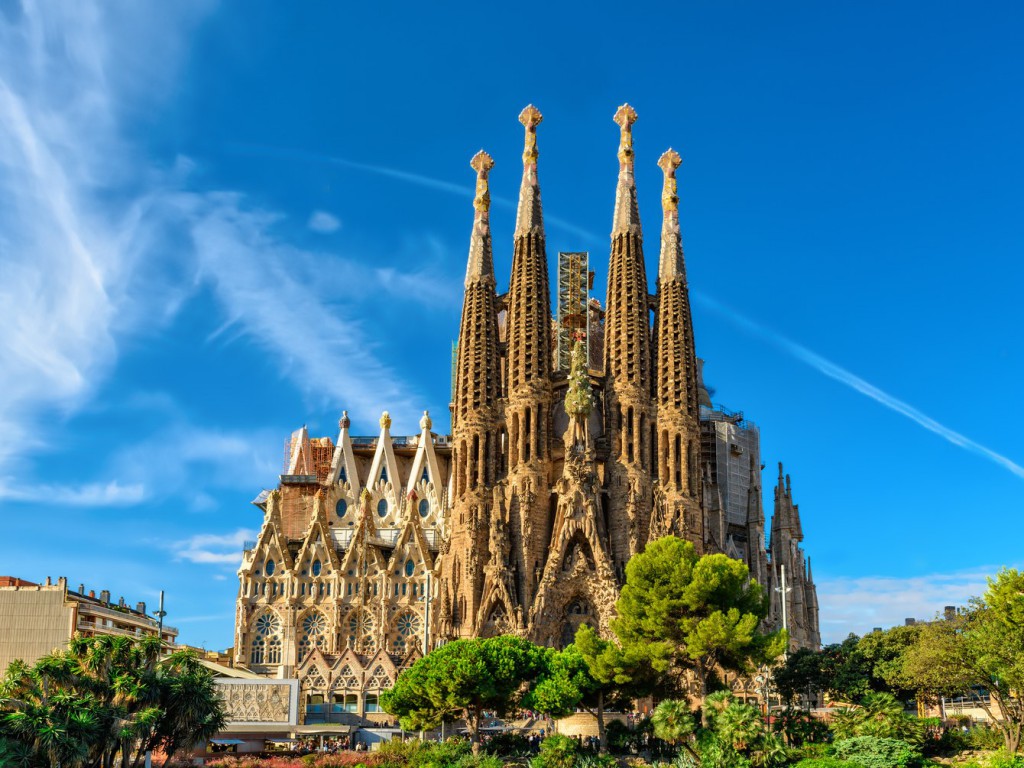
The Basílica i Temple Expiatori de la Sagrada Família (Catalan pronunciation: [səˈɣɾaðə fəˈmili.ə]; Spanish: Basílica y Templo Expiatorio de la Sagrada Familia; English: Basilica and Expiatory Church of the Holy Family) is a large unfinished Roman Catholic church in Barcelona, designed by Catalan architect Antoni Gaudí (1852–1926). Gaudí’s work on the building is part of a UNESCO World Heritage Site. In November 2010 Pope Benedict XVI consecrated and proclaimed it a minor basilica, as distinct from a cathedral, which must be the seat of a bishop.
In 1882, construction of Sagrada Família started under architect Francisco de Paula del Villar. In 1883, when Villar resigned, Gaudí took over as chief architect, transforming the project with his architectural and engineering style, combining Gothic and curvilinear Art Nouveau forms. Gaudí devoted the remainder of his life to the project, and he is buried in the crypt. At the time of his death at age 73 in 1926, when he was run down by a tram, less than a quarter of the project was complete.
Relying solely on private donations, Sagrada Familia’s construction progressed slowly and was interrupted by the Spanish Civil War. In July 1936, revolutionaries set light to the crypt and broke their way into the workshop, partially destroying Gaudí’s original plans, drawings and plaster models, which led to 16 years work to piece together the fragments of the master model. Construction resumed to intermittent progress in the 1950s. Advancements in technologies such as computer aided design and computerised numerical control (CNC) have since enabled faster progress and construction passed the midpoint in 2010. However, some of the project’s greatest challenges remain, including the construction of ten more spires, each symbolising an important Biblical figure in the New Testament. It is anticipated that the building can be completed by 2026—the centenary of Gaudí’s death.
The basilica has a long history of dividing the citizens of Barcelona: over the initial possibility it might compete with Barcelona’s cathedral, over Gaudí’s design itself, over the possibility that work after Gaudí’s death disregarded his design, and the 2007 proposal to build a tunnel of Spain’s high-speed rail link to France which could disturb its stability. Describing Sagrada Família, art critic Rainer Zerbst said “it is probably impossible to find a church building anything like it in the entire history of art”, and Paul Goldberger describes it as “the most extraordinary personal interpretation of Gothic architecture since the Middle Ages”.
BasílicaiTemple Expiatori de laSagradaFamília(加泰羅尼亞語發音:[səɣɾaðəfəmili.ə];西班牙語:BasílicypTemplo Expiatorio de la Sagrada Familia;英語:Basilica and Expiatory Church of the Holy Family)是一個未完成的大型羅馬天主教堂。巴塞羅那,由加泰羅尼亞建築師安東尼高迪(1852-1926)設計。高迪在該建築上的工作是聯合國教科文組織世界遺產的一部分。 2010年11月,教皇本篤十六世奉獻並宣布它為一座小教堂,與大教堂不同,大教堂必須是主教的所在地。
1882年,SagradaFamília的建築始於建築師Francisco de Paula del Villar。 1883年,當比利亞辭職時,高迪接任首席建築師,用他的建築和工程風格改造了這個項目,結合了哥特式和曲線式的新藝術形式。高迪將餘生獻給了這個項目,他被埋葬在地下室裡。在他1926年去世時,當他被電車撞倒時,不到四分之一的項目完成了。
僅僅依靠私人捐款,聖家族教堂的建設進展緩慢,並被西班牙內戰打斷。 1936年7月,革命者為地窖設置了燈光並闖入車間,部分摧毀了高迪的原始計劃,圖紙和石膏模型,這導致了16年的工作,將主模型的碎片拼湊在一起。 20世紀50年代,施工恢復了間歇性進展。計算機輔助設計和計算機數控(CNC)等技術的進步使得更快的進步和施工在2010年通過了中點。然而,該項目的一些最大的挑戰仍然存在,包括建造十個尖塔,每個尖塔都像徵著一個重要的新約中的聖經人物。預計該建築可以在2026年完成 – 高迪死亡一百週年。
大教堂有著悠久的分裂巴塞羅那公民的歷史:最初的可能性是它可能與巴塞羅那的大教堂競爭,而不是高迪的設計本身,因為高迪死後的工作無視他的設計,以及2007年建造隧道的建議。西班牙與法國的高速鐵路連接可能會影響其穩定性。藝術評論家Rainer Zerbst描述了SagradaFamília,他說“在整個藝術史上找到類似教堂的建築可能是不可能的”,Paul Goldberger將其描述為“自中世紀以來對哥特式建築的最獨特的個人解釋” 。
Religion
Affiliation:Roman Catholic
District:Barcelona
Ecclesiastical or organizational status:Minor basilica
Leadership:His Eminence Juan Josep Cardinal Omella, Archbishop of Barcelona
Year consecrated:7 November 2010
Status:Active/incomplete
Location
Location:Barcelona, Catalonia, Spain
Geographic coordinates:41°24′13″N 2°10′28″ECoordinates: 41°24′13″N 2°10′28″E
Architecture
Architect(s):Antoni Gaudí
Architectural style:Modernisme
General contractor:Construction Board of La Sagrada Família Foundation
Groundbreaking:1882; 137 years ago
Completed:structural work 2026 (2017 estimate)
decorations 2032
Specifications
Direction of façade:Southeast
Capacity:9,000
Length:90 m (300 ft)
Width:60 m (200 ft)
Width (nave):45 m (150 ft)
Spire(s):18 (8 already built)
Spire height:170 m (560 ft) (planned)
Spanish Property of Cultural Interest
Official name: Templo Expiatorio de la Sagrada Familia
Type:Monument – Basilica
24 July 1969
UNESCO World Heritage Site
Part of:Works of Antoni Gaudí
Criteria:Cultural: i, ii, iv
Reference:320-005
Inscription:2005 (29th Session)
宗教
隸屬:羅馬天主教徒
地區:巴塞羅那
教會或組織狀況:小教堂
領導力:巴塞羅那大主教Juan Josep Cardinal Omella
奉獻年份:2010年11月7日
狀態:活動/不完整
地點
地點:巴塞羅那,加泰羅尼亞,西班牙
地理坐標:41°24’13“N 2°10’28”ECoordinates:41°24’13“N 2°10’28”E
建築
建築師:AntoniGaudí
建築風格:Modernisme
總承包商:LaSagradaFamília基金會建築委員會
突破性:1882; 137年前
完成:結構工作2026(2017年估計)
裝飾品2032
產品規格
立面方向:東南部
容量::9000
長度:90米(300英尺)
寬度:60米(200英尺)
寬度(中殿):45米(150英尺)
Spire(s):18(已建8個)
尖頂高度:170米(560英尺)(計劃中)
西班牙文化利益屬性
官方名稱:Templo Expiatorio de la Sagrada Familia
類型:紀念碑 – 大教堂
1969年7月24日
聯合國教科文組織世界遺產
部分:安東尼高迪的作品
標準:文化:i,ii,iv
參考:320-005
銘文:2005年(第29屆)
On the subject of the extremely long construction period, Gaudí is said to have remarked: “My client is not in a hurry.” When Gaudí died in 1926, the basilica was between 15 and 25 percent complete. After Gaudí’s death, work continued under the direction of Domènec Sugrañes i Gras until interrupted by the Spanish Civil War in 1936.
Parts of the unfinished basilica and Gaudí’s models and workshop were destroyed during the war by Catalan anarchists. The present design is based on reconstructed versions of the plans that were burned in a fire as well as on modern adaptations. Since 1940 the architects Francesc Quintana, Isidre Puig Boada, Lluís Bonet i Gari and Francesc Cardoner have carried on the work. The illumination was designed by Carles Buïgas. The current director and son of Lluís Bonet, Jordi Bonet i Armengol, has been introducing computers into the design and construction process since the 1980s. Mark Burry of New Zealand serves as Executive Architect and Researcher. Sculptures by J. Busquets, Etsuro Sotoo and the controversial Josep Maria Subirachs decorate the fantastical façades. Barcelona-born Jordi Fauli took over as chief architect in 2012.
The central nave vaulting was completed in 2000 and the main tasks since then have been the construction of the transept vaults and apse. As of 2006, work concentrated on the crossing and supporting structure for the main steeple of Jesus Christ as well as the southern enclosure of the central nave, which will become the Glory façade.
The church shares its site with the Sagrada Família Schools building, a school originally designed by Gaudí in 1909 for the children of the construction workers. Relocated in 2002 from the eastern corner of the site to the southern corner, the building now houses an exhibition.
關於建設週期極長的問題,據說高迪曾說過:“我的客戶並不著急。”當高迪於1926年去世時,大教堂完成了15%至25%。高迪去世後,在DomènecSugrañesiGras的指導下繼續工作,直到1936年西班牙內戰中斷。
加泰羅尼亞無政府主義者在戰爭期間摧毀了部分未完工的大教堂和高迪的模型和車間。目前的設計基於在火災中燃燒的計劃的重建版本以及現代改編。自1940年以來,建築師Francesc Quintana,Isidre Puig Boada,LluísBoneti Gari和Francesc Cardoner繼續開展這項工作。照明由CarlesBuïgas設計。現任導演兼LluísBonet的兒子Jordi Bonet i Armengol自20世紀80年代以來一直將計算機引入設計和施工過程。新西蘭的Mark Burry擔任執行建築師和研究員。 J. Busquets,Etsuro Sotoo和備受爭議的Josep Maria Subirachs的雕塑裝飾了夢幻般的外立面。出生於巴塞羅那的Jordi Fauli於2012年接任首席建築師。
中央的中殿拱頂在2000年完成,從那時起的主要任務是建造橫斷面拱頂和後殿。截至2006年,工作集中在耶穌基督主尖塔的交叉和支撐結構以及中央教堂中殿的南部圍牆,這將成為榮耀的外觀。
教堂與SagradaFamília學校建築共享其遺址,該建築最初由高迪於1909年為建築工人的孩子設計。該建築於2002年從該遺址的東角搬遷至南角,現在有一個展覽。
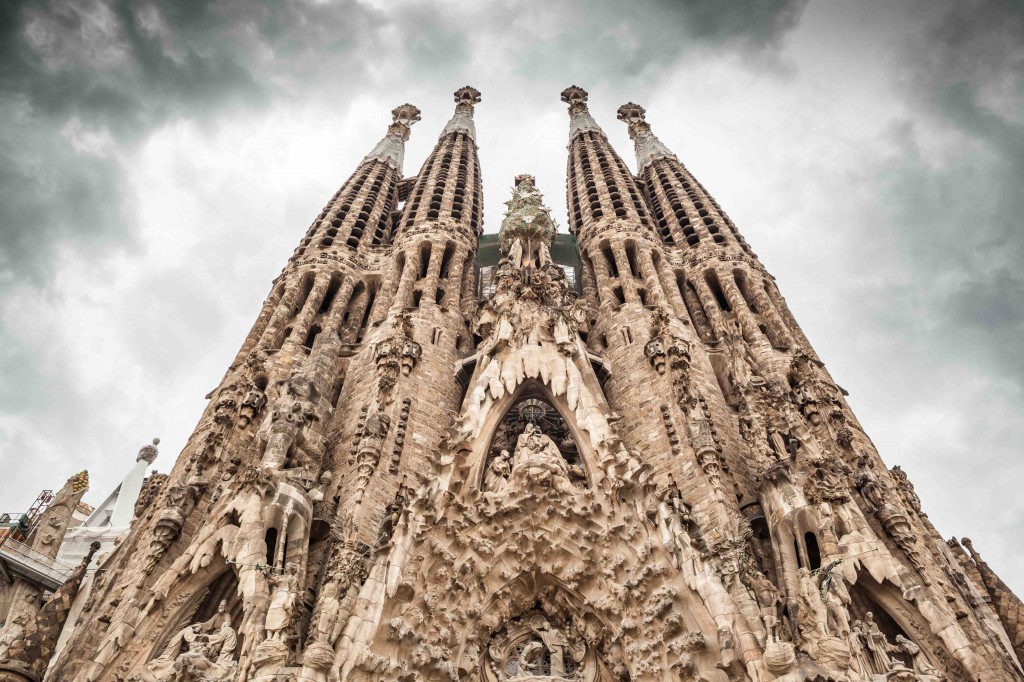
Chief architect Jordi Fauli announced in October 2015 that construction is 70 percent complete and has entered its final phase of raising six immense steeples. The steeples and most of the church’s structure are to be completed by 2026, the centennial of Gaudí’s death; decorative elements should be complete by 2030 or 2032. Visitor entrance fees of 15–20 euros finance the annual construction budget of 25 million euros .
Computer-aided design technology has been used to accelerate construction of the building. Current technology allows stone to be shaped off-site by a CNC milling machine, whereas in the 20th century the stone was carved by hand.
In 2008, some renowned Catalan architects advocated halting construction,to respect Gaudí’s original designs, which although they were not exhaustive and were partially destroyed, have been partially reconstructed in recent years.
In 2018, the stone type needed for the construction was found in a quarry in Brinscall, near Chorley, England
首席建築師Jordi Fauli在2015年10月宣佈建築完成70%,並已進入最後階段,即提升六個巨大的尖頂。 尖塔和大部分教堂的結構將於2026年完成,即高迪死亡一百週年; 裝飾元素應在2030年或2032年完成。訪客入場費為15-20歐元,每年的建設預算為2500萬歐元。
計算機輔助設計技術已被用於加速建築物的建造。 目前的技術允許通過CNC銑床將石頭成形為異地,而在20世紀,石頭是用手工雕刻的。
2008年,一些著名的加泰羅尼亞建築師主張停止施工,尊重高迪的原始設計,雖然它們並非詳盡無遺且部分被毀,但近年來已經部分重建。
2018年,在英國喬利附近的Brinscall的一個採石場發現了建造所需的石材類型。

AVE tunnel
Since 2013, AVE high-speed trains have passed near the Sagrada Família through a tunnel that runs beneath the centre of Barcelona.
The tunnel’s construction, which began on 26 March 2010, was controversial. The Ministry of Public Works of Spain (Ministerio de Fomento) claimed the project posed no risk to the church. Sagrada Família engineers and architects disagreed, saying there was no guarantee that the tunnel would not affect the stability of the building. The Board of the Sagrada Família (Patronat de la Sagrada Família) and the neighborhood association AVE pel Litoral (AVE by the Coast) had led a campaign against this route for the AVE, without success.
In October 2010, the tunnel boring machine reached the church underground under the location of the building’s principal façade. Service through the tunnel was inaugurated on 8 January 2013. Track in the tunnel makes use of a system by Edilon Sedra in which the rails are embedded in an elastic material to dampen vibrations. No damage to the Sagrada Família has been reported to date.
AVE隧道
自2013年以來,AVE高速列車通過位於巴塞羅那市中心下方的隧道經過SagradaFamília附近。
該隧道的建設始於2010年3月26日,但仍存在爭議。西班牙公共工程部(Ministerio de Fomento)聲稱該項目對教會沒有任何風險。 SagradaFamília工程師和建築師不同意,並表示不能保證隧道不會影響建築物的穩定性。 SagradaFamília(Patronat de laSagradaFamília)和鄰居AVE pel Litoral(AVE by the Coast)的董事會領導了一場反對AVE這條路線的運動,但沒有成功。
2010年10月,隧道掘進機在建築物主要立面的位置下到達地下教堂。通過隧道的服務於2013年1月8日開始。隧道中的軌道利用Edilon Sedra的系統,其中軌道嵌入彈性材料中以抑制振動。迄今為止,據報導沒有對SagradaFamília造成任何損害。
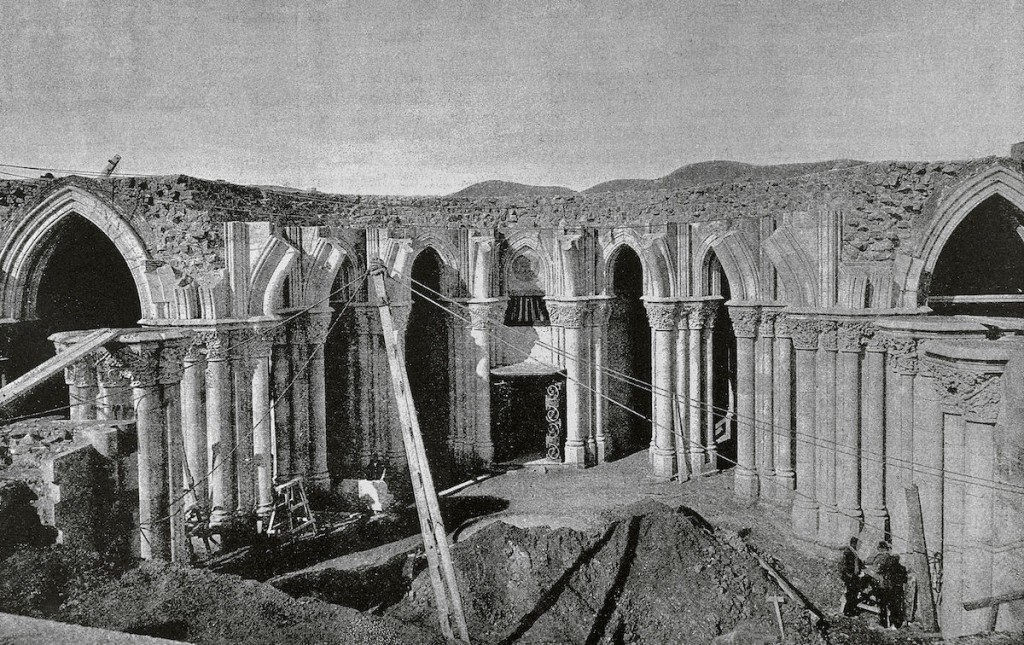
Design
The style of la Sagrada Família is variously likened to Spanish Late Gothic, Catalan Modernism and to Art Nouveau or Catalan Noucentisme. While the Sagrada Família falls within the Art Nouveau period, Nikolaus Pevsner points out that, along with Charles Rennie Mackintosh in Glasgow, Gaudí carried the Art Nouveau style far beyond its usual application as a surface decoration.
設計
laSagradaFamília的風格與西班牙晚期哥特式,加泰羅尼亞現代主義和新藝術風格或加泰羅尼亞Noucentisme不同。 雖然SagradaFamília屬於新藝術運動時期,但Nikolaus Pevsner指出,與格拉斯哥的Charles Rennie Mackintosh一起,高迪的新藝術運動風格遠遠超出其通常的表面裝飾風格。

Plan
While never intended to be a cathedral (seat of a bishop), the Sagrada Família was planned from the outset to be a cathedral-sized building. Its ground-plan has obvious links to earlier Spanish cathedrals such as Burgos Cathedral, León Cathedral and Seville Cathedral. In common with Catalan and many other European Gothic cathedrals, the Sagrada Família is short in comparison to its width, and has a great complexity of parts, which include double aisles, an ambulatory with a chevet of seven apsidal chapels, a multitude of steeples and three portals, each widely different in structure as well as ornament. Where it is common for cathedrals in Spain to be surrounded by numerous chapels and ecclesiastical buildings, the plan of this church has an unusual feature: a covered passage or cloister which forms a rectangle enclosing the church and passing through the narthex of each of its three portals. With this peculiarity aside, the plan, influenced by Villar’s crypt, barely hints at the complexity of Gaudí’s design or its deviations from traditional church architecture. There are no exact right angles to be seen inside or outside the church, and few straight lines in the design.
計劃
雖然從未打算成為一座大教堂(主教所在地),但SagradaFamília從一開始就被規劃為一座大教堂大小的建築。它的平面圖與早期的西班牙大教堂有明顯的聯繫,如布爾戈斯大教堂,萊昂大教堂和塞維利亞大教堂。與加泰羅尼亞和許多其他歐洲哥特式大教堂一樣,SagradaFamília與其寬度相比較短,並且具有極其複雜的部件,包括雙通道,帶七個無人機小教堂的車道,多個尖頂和三個門戶,每個門戶在結構和裝飾上都有很大差異。在西班牙的大教堂被眾多教堂和教堂建築所包圍的地方,這座教堂的計劃有一個不同尋常的特點:一個有蓋的通道或迴廊,形成一個圍繞教堂的矩形,並穿過三個教堂的每一個的narthex門戶。拋開這種特殊性,受Villar的地下室影響的計劃幾乎沒有暗示高迪設計的複雜性或其與傳統教堂建築的偏差。教堂內外沒有確切的直角,設計中幾條直線。
Spires
Gaudí’s original design calls for a total of eighteen spires, representing in ascending order of height the Twelve Apostles, the Virgin Mary, the four Evangelists and, tallest of all, Jesus Christ. Eight spires have been built as of 2010, corresponding to four apostles at the Nativity façade and four apostles at the Passion façade.
According to the 2005 “Works Report” of the project’s official website, drawings signed by Gaudí and recently found in the Municipal Archives, indicate that the spire of the Virgin was in fact intended by Gaudí to be shorter than those of the evangelists. The spire height will follow Gaudí’s intention, which according to the report will work with the existing foundation.
The Evangelists’ spires will be surmounted by sculptures of their traditional symbols: a winged bull (Saint Luke), a winged man (Saint Matthew), an eagle (Saint John), and a winged lion (Saint Mark). The central spire of Jesus Christ is to be surmounted by a giant cross; its total height (170 metres (560 ft)) will be one metre less than that of Montjuïc hill in Barcelona as Gaudí believed that his creation should not surpass God’s. The lower spires are surmounted by communion hosts with sheaves of wheat and chalices with bunches of grapes, representing the Eucharist. Plans call for tubular bells to be placed within the spires, driven by the force of the wind, and driving sound down into the interior of the church. Gaudí performed acoustic studies to achieve the appropriate acoustic results inside the temple. However, only one bell is currently in place.
The completion of the spires will make Sagrada Família the tallest church building in the world.
尖塔
高迪的原始設計需要總共十八個尖頂,代表十二使徒,聖母瑪利亞,四位福音傳教士以及最高的耶穌基督的高度升序。截至2010年,已建成八座尖頂,相當於耶穌誕生外牆的四位使徒和激情外牆的四位使徒。
根據該項目官方網站2005年的“工程報告”,高迪簽署並最近在市檔案館中發現的圖紙表明,高迪的宗教信仰實際上是比傳教士更短的。尖頂高度將遵循高迪的意圖,根據該報告將與現有的基礎一起使用。
福音傳教士的尖頂將被他們傳統符號的雕塑所擊敗:一頭有翅膀的公牛(聖盧克),一隻帶翅膀的人(聖馬太),一隻鷹(聖約翰)和一隻帶翅膀的獅子(聖馬克)。耶穌基督的中心尖頂將由一個巨大的十字架超越;它的總高度(170米(560英尺))將比巴塞羅那的蒙特惠奇山低一米,因為高迪認為他的創造不應超過上帝的。較低的尖頂被聖餐主人所覆蓋,上面有小麥和帶有葡萄串的chalices,代表著聖體聖事。計劃要求將管狀鐘放置在尖頂內,由風力驅動,並將聲音傳送到教堂內部。高迪進行聲學研究,以在寺廟內獲得適當的聲學效果。但是,目前只有一個鈴。
尖頂的完工將使聖家堂成為世界上最高的教堂建築。
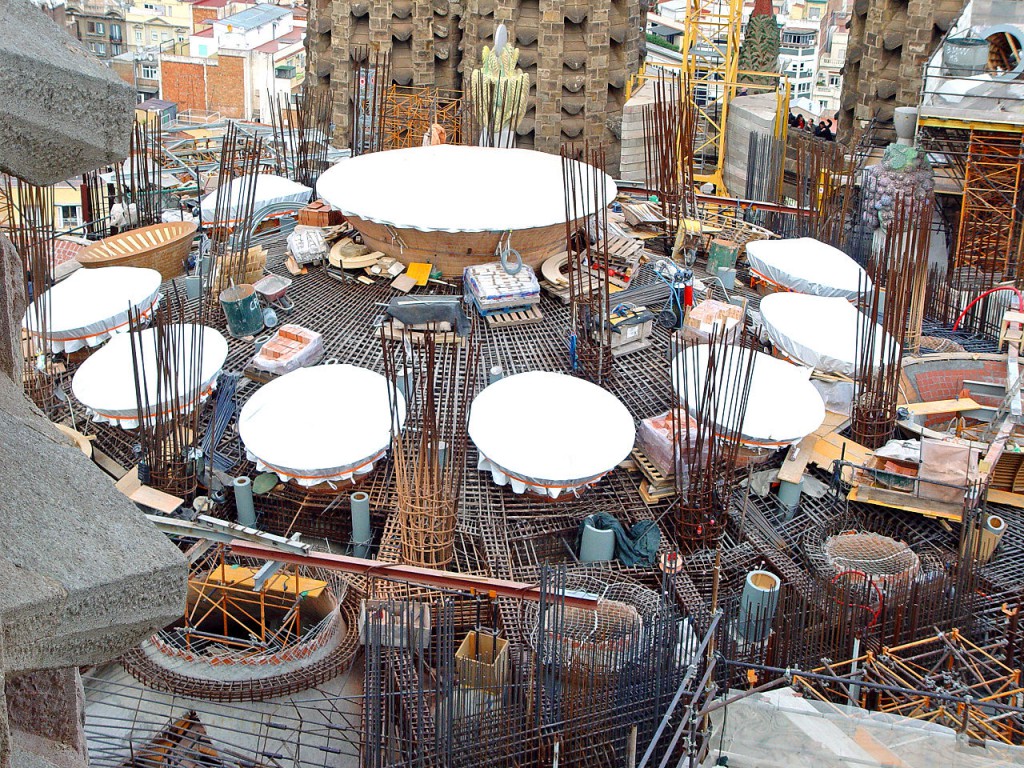
Façades
The Church will have three grand façades: the Nativity façade to the East, the Passion façade to the West, and the Glory façade to the South (yet to be completed). The Nativity Façade was built before work was interrupted in 1935 and bears the most direct Gaudí influence. The Passion façade was built according to the design that Gaudi created in 1917. The construction began in 1954, and the steeples, built over the elliptical plan, were finished in 1976. It is especially striking for its spare, gaunt, tormented characters, including emaciated figures of Christ being scourged at the pillar; and Christ on the Cross. These controversial designs are the work of Josep Maria Subirachs. The Glory façade, on which construction began in 2002, will be the largest and most monumental of the three and will represent one’s ascension to God. It will also depict various scenes such as Hell, Purgatory, and will include elements such as the Seven deadly sins and the Seven heavenly virtues.
幕牆
教堂將有三個宏偉的外立面:東部的耶穌誕生外觀,西部的激情外觀和南部的榮耀外觀(尚未完工)。耶穌誕生的外牆是在1935年工作中斷之前建造的,並且具有最直接的高迪影響。 Passionfaçade是根據高迪於1917年創造的設計建造的。建築始於1954年,建於橢圓計劃上的尖頂於1976年完工。它的備用,憔悴,受折磨的角色特別引人注目,包括基督被鞭打在柱子上的憔悴的人物;和基督在十字架上。這些有爭議的設計是Josep Maria Subirachs的作品。 2002年開始建造的榮耀外牆將成為三者中最大和最具紀念意義的,將代表一個人向上帝的提升。它還將描繪諸如地獄,煉獄之類的各種場景,並將包括七種致命罪和七種天國美德等元素。
Nativity Façade
Sculpture of the choir of angel children
Constructed between 1894 and 1930, the Nativity façade was the first façade to be completed. Dedicated to the birth of Jesus, it is decorated with scenes reminiscent of elements of life. Characteristic of Gaudí’s naturalistic style, the sculptures are ornately arranged and decorated with scenes and images from nature, each a symbol in its own manner. For instance, the three porticos are separated by two large columns, and at the base of each lies a turtle or a tortoise (one to represent the land and the other the sea; each are symbols of time as something set in stone and unchangeable). In contrast to the figures of turtles and their symbolism, two chameleons can be found at either side of the façade, and are symbolic of change.
The façade faces the rising sun to the northeast, a symbol for the birth of Christ. It is divided into three porticos, each of which represents a theological virtue (Hope, Faith and Charity). The Tree of Life rises above the door of Jesus in the portico of Charity. Four steeples complete the façade and are each dedicated to a Saint (Matthias, Barnabas, Jude the Apostle, and Simon the Zealot).
Originally, Gaudí intended for this façade to be polychromed, for each archivolt to be painted with a wide array of colours. He wanted every statue and figure to be painted. In this way the figures of humans would appear as much alive as the figures of plants and animals.
Gaudí chose this façade to embody the structure and decoration of the whole church. He was well aware that he would not finish the church and that he would need to set an artistic and architectural example for others to follow. He also chose for this façade to be the first on which to begin construction and for it to be, in his opinion, the most attractive and accessible to the public. He believed that if he had begun construction with the Passion Façade, one that would be hard and bare (as if made of bones), before the Nativity Façade, people would have withdrawn at the sight of it. Some of the statues were destroyed in 1936 during the Spanish Civil War, and subsequently were reconstructed by the Japanese artist Etsuro Sotoo.
耶穌誕生的外觀
天使孩子唱詩班的雕塑
建於1894年至1930年之間的Nativity外牆是第一個完工的外牆。致力於耶穌的誕生,它裝飾著讓人想起生活元素的場景。高迪的自然主義風格的特點,雕塑華麗地安排和裝飾自然的場景和圖像,每個都是自己的方式的象徵。例如,三個門廊被兩個大柱隔開,每個柱子底部有一隻烏龜或烏龜(一隻代表陸地,另一隻代表海洋;每種都是時間的象徵,就像石頭上的東西一樣,不變) 。與海龜的形象及其像徵意義相反,在立面的兩側都可以找到兩個變色龍,它們是變化的象徵。
外立面朝向東北方向的太陽升起,是基督誕生的象徵。它分為三個門廊,每個門廊代表一種神學美德(希望,信仰和慈善)。生命之樹在慈善門廊中升到了耶穌的門上。四個尖塔完成了外觀,每個都是獻給聖徒(馬提亞斯,巴拿巴,使徒猶豫,和狂熱者西蒙)。
最初,高迪希望這個立面是多色的,每個archivolt都要塗上各種各樣的顏色。他希望每個雕像和人物都被畫上。通過這種方式,人類的數字看起來就像植物和動物的數字一樣活躍。
高迪選擇這個外觀來體現整個教堂的結構和裝飾。他很清楚他不會完成教會,他需要為其他人設定一個藝術和建築的例子。他還選擇將這個立面作為第一個開始建設的立面,並且在他看來,它是最吸引人的,並且對公眾開放。他相信,如果他開始建造激情外牆,那將是堅硬而光禿的(彷彿由骨頭製成),在耶穌誕生的外牆之前,人們會在看到它時撤回。一些雕像在1936年西班牙內戰期間被摧毀,隨後由日本藝術家Etsuro Sotoo重建。
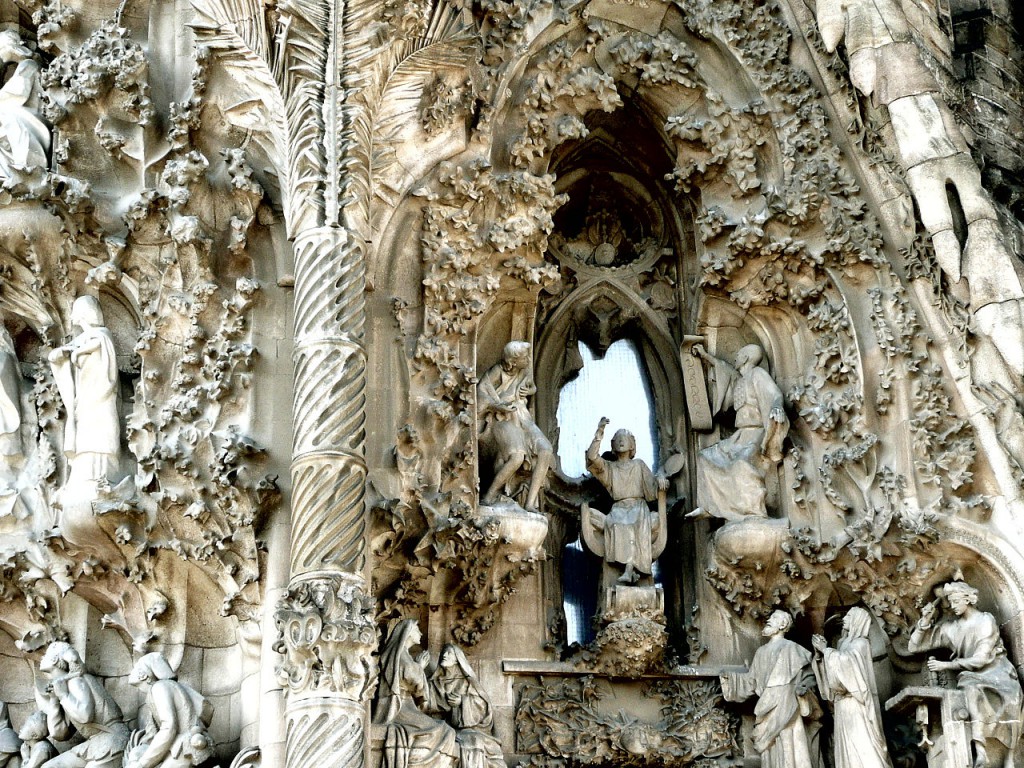
Passion Façade
In contrast to the highly decorated Nativity Façade, the Passion Façade is austere, plain and simple, with ample bare stone, and is carved with harsh straight lines to resemble the bones of a skeleton. Dedicated to the Passion of Christ, the suffering of Jesus during his crucifixion, the façade was intended to portray the sins of man. Construction began in 1954, following the drawings and instructions left by Gaudí for future architects and sculptors. The steeples were completed in 1976, and in 1987 a team of sculptors, headed by Josep Maria Subirachs, began work sculpting the various scenes and details of the façade. They aimed to give a rigid, angular form to provoke a dramatic effect. Gaudí intended for this façade to strike fear into the onlooker. He wanted to “break” arcs and “cut” columns, and to use the effect of chiaroscuro (dark angular shadows contrasted by harsh rigid light) to further show the severity and brutality of Christ’s sacrifice.
Facing the setting sun, indicative and symbolic of the death of Christ, the Passion Façade is supported by six large and inclined columns, designed to resemble Sequoia trunks. Above there is a pyramidal pediment, made up of eighteen bone-shaped columns, which culminate in a large cross with a crown of thorns. Each of the four steeples is dedicated to an apostle (James, Thomas, Philip, and Bartholomew) and, like the Nativity Façade, there are three porticos, each representing the theological virtues, though in a much different light.
The scenes sculpted into the façade may be divided into three levels, which ascend in an S form and reproduce the stations of the Cross (Via Crucis of Christ). The lowest level depicts scenes from Jesus’ last night before the crucifixion, including the Last Supper, Kiss of Judas, Ecce homo, and the Sanhedrin trial of Jesus. The middle level portrays the Calvary, or Golgotha, of Christ, and includes The Three Marys, Saint Longinus, Saint Veronica, and a hollow-face illusion of Christ on the Veil of Veronica. In the third and final level the Death, Burial and the Resurrection of Christ can be seen. A bronze figure situated on a bridge creating a link between the steeples of Saint Bartholomew and Saint Thomas represents the Ascension of Jesus.
The façade contains a magic square based on the magic square in the 1514 print Melencolia I. The square is rotated and one number in each row and column is reduced by one so the rows and columns add up to 33 instead of the standard 34 for a 4×4 magic square.
激情外觀
與高度裝飾的NativityFaçade相比,PassionFaçade簡潔樸素,簡潔,裸露的石頭,雕刻著刺骨的直線,類似骨架的骨頭。致力於基督的受難,耶穌在被釘十字架的過程中受苦,這個外表旨在描繪人類的罪惡。建築始於1954年,遵循高迪為未來的建築師和雕塑家留下的圖紙和指示。這些尖塔於1976年完工,1987年,由Josep Maria Subirachs領導的雕塑家團隊開始雕刻各種場景和立面細節。他們的目的是提供一種剛性的,有角度的形式,以激發戲劇性的效果。高迪打算讓這個立面對旁觀者產生恐懼。他希望“打破”弧線和“切割”柱子,並利用明暗對比(暗角形陰影與嚴酷的剛性光線形成對比)的效果來進一步顯示基督犧牲的嚴重性和殘酷性。
面對夕陽,指示和象徵著基督的死亡,PassionFaçade由六個大而傾斜的柱子支撐,設計類似於紅杉樹幹。上面有一個金字塔形的山形牆,由十八個骨形柱子組成,最終形成一個帶有荊棘冠冕的大十字架。四個尖塔中的每一個都是獻給使徒(詹姆斯,托馬斯,菲利普和巴塞洛繆),並且像耶穌誕生的外牆一樣,有三個門廊,每個都代表著神學的美德,儘管它們有著截然不同的光芒。
雕刻成立面的場景可以分為三個層次,以S形式提升並再現十字架(通過基督的十字架)。最低級別描繪了耶穌在被釘十字架前的最後一晚的場景,包括最後的晚餐,猶大之吻,Ecce同性戀和耶穌的公會審判。中間層面描繪了基督的Cal髏地或各各他,包括三個瑪麗,聖Longinus,聖維羅尼卡,以及維羅尼卡面紗上的一個空洞的基督幻覺。在第三級也是最後一級,可以看到基督的死亡,埋葬和復活。位於橋上的青銅人物在聖巴塞洛繆和聖托馬斯的尖塔之間建立了聯繫,代表著耶穌的升天。
正麵包含一個魔術方塊,基於1514年印刷Melencolia I中的魔方。旋轉方塊,每行和每列中的一個數字減1,因此行和列加起來為33而不是標準34 4×4魔方。
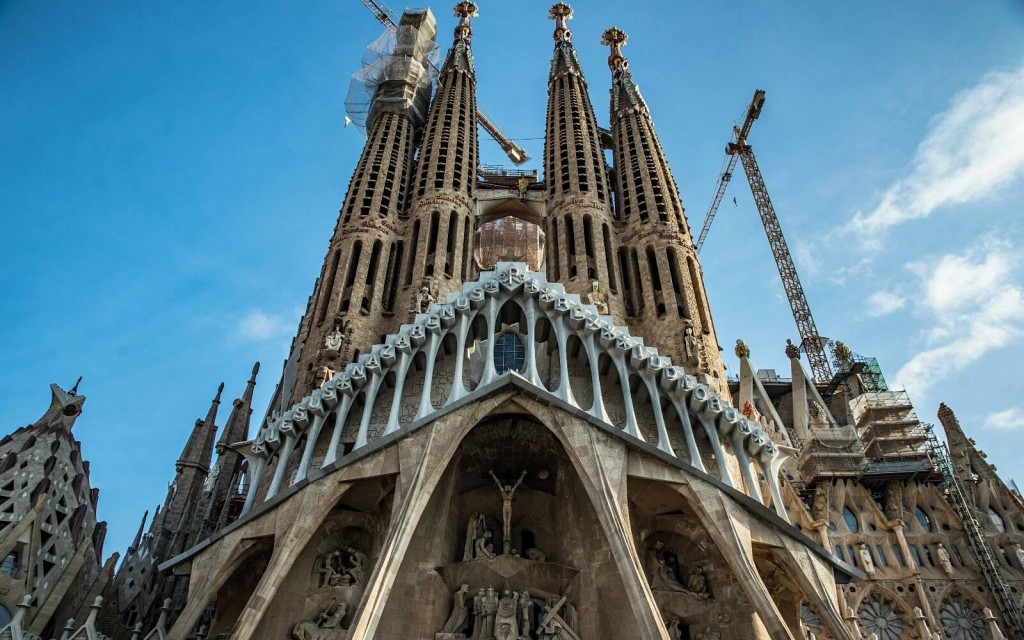
Interior
The church plan is that of a Latin cross with five aisles. The central nave vaults reach forty-five metres (148 feet) while the side nave vaults reach thirty metres (98 feet). The transept has three aisles. The columns are on a 7.5 metre (25 ft) grid. However, the columns of the apse, resting on del Villar’s foundation, do not adhere to the grid, requiring a section of columns of the ambulatory to transition to the grid thus creating a horseshoe pattern to the layout of those columns. The crossing rests on the four central columns of porphyry supporting a great hyperboloid surrounded by two rings of twelve hyperboloids (currently under construction). The central vault reaches sixty metres (200 feet). The apse is capped by a hyperboloid vault reaching seventy-five metres (246 feet). Gaudí intended that a visitor standing at the main entrance be able to see the vaults of the nave, crossing, and apse; thus the graduated increase in vault loft.
There are gaps in the floor of the apse, providing a view down into the crypt below.
The columns of the interior are a unique Gaudí design. Besides branching to support their load, their ever-changing surfaces are the result of the intersection of various geometric forms. The simplest example is that of a square base evolving into an octagon as the column rises, then a sixteen-sided form, and eventually to a circle. This effect is the result of a three-dimensional intersection of helicoidal columns (for example a square cross-section column twisting clockwise and a similar one twisting counter-clockwise).
Essentially none of the interior surfaces are flat; the ornamentation is comprehensive and rich, consisting in large part of abstract shapes which combine smooth curves and jagged points. Even detail-level work such as the iron railings for balconies and stairways are full of curvaceous elaboration.
Organ
In 2010 an organ was installed in the chancel by the Blancafort Orgueners de Montserrat organ builders. The instrument has 26 stops (1,492 pipes) on two manuals and a pedalboard.
To overcome the unique acoustical challenges posed by the church’s architecture and vast size, several additional organs will be installed at various points within the building. These instruments will be playable separately (from their own individual consoles) and simultaneously (from a single mobile console), yielding an organ of some 8000 pipes when completed.
內部
教會計劃是一個拉丁十字架,有五個過道。中央的中殿拱頂高達45米(148英尺),而中殿的拱頂高達30米(98英尺)。 transept有三個過道。這些柱子位於7.5米(25英尺)的網格上。然而,在del Villar的基礎上放置的後殿的柱子不會粘附到網格上,需要移動的一部分柱子過渡到網格,從而為這些柱子的佈局創建馬蹄形圖案。這個交叉點位於斑岩的四個中央柱上,支撐著一個巨大的雙曲面,周圍環繞著兩個十二個雙極環(目前正在建造中)。中央拱頂達到六十米(200英尺)。後殿的頂部是一個高達75米(246英尺)的雙曲面拱頂。高迪希望站在正門的遊客能夠看到教堂中殿,十字路口和後殿的拱頂;因此,拱頂閣樓逐漸增加。
後殿的地板上有間隙,可以看到下方的地下室。
內飾的柱子是獨特的高迪設計。除了支撐其負載的分支外,它們不斷變化的表面是各種幾何形狀交叉的結果。最簡單的例子是當柱子上升時形成八邊形的正方形基底,然後是十六面形狀,最終變成圓形。這種效應是螺旋柱的三維交叉的結果(例如,順時針扭轉的方形橫截面柱和逆時針扭轉的類似橫截面柱)。
基本上沒有一個內表面是平的;裝飾是全面而豐富的,包括大部分抽象形狀,結合平滑的曲線和鋸齒狀的點。即使是細節級的工作,如陽台和樓梯的鐵欄杆,也充滿了曲線美。
器官
2010年,Blancafort Orgueners de Montserrat風琴建造者在聖壇上安裝了一個風琴。該儀器在兩個手冊和一個踏板上有26個擋塊(1,492個管道)。
為了克服教堂建築和巨大尺寸帶來的獨特聲學挑戰,將在建築物內的不同位置安裝幾個額外的器官。這些樂器可以單獨播放(從他們自己的個人控制台)和同時(從單個移動控制台)播放,完成後可以產生大約8000個管道的風琴。
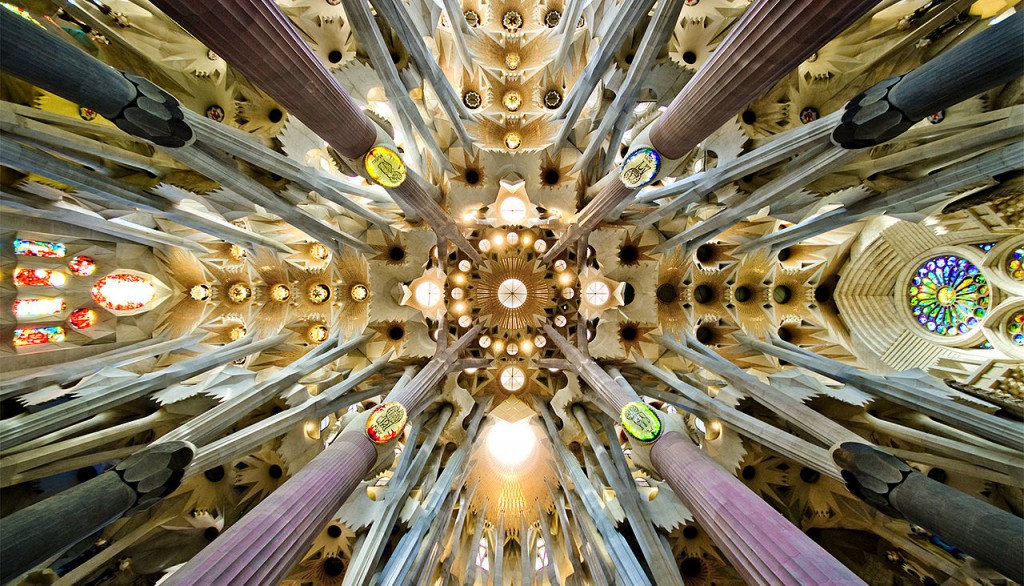

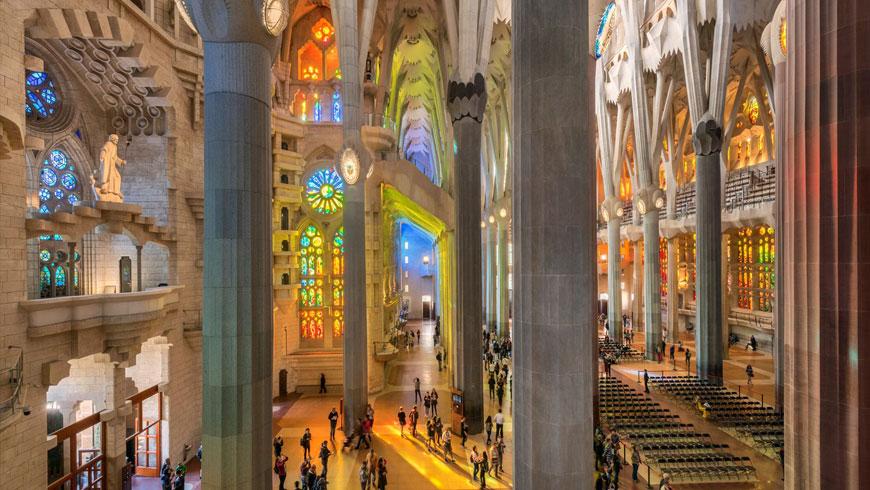
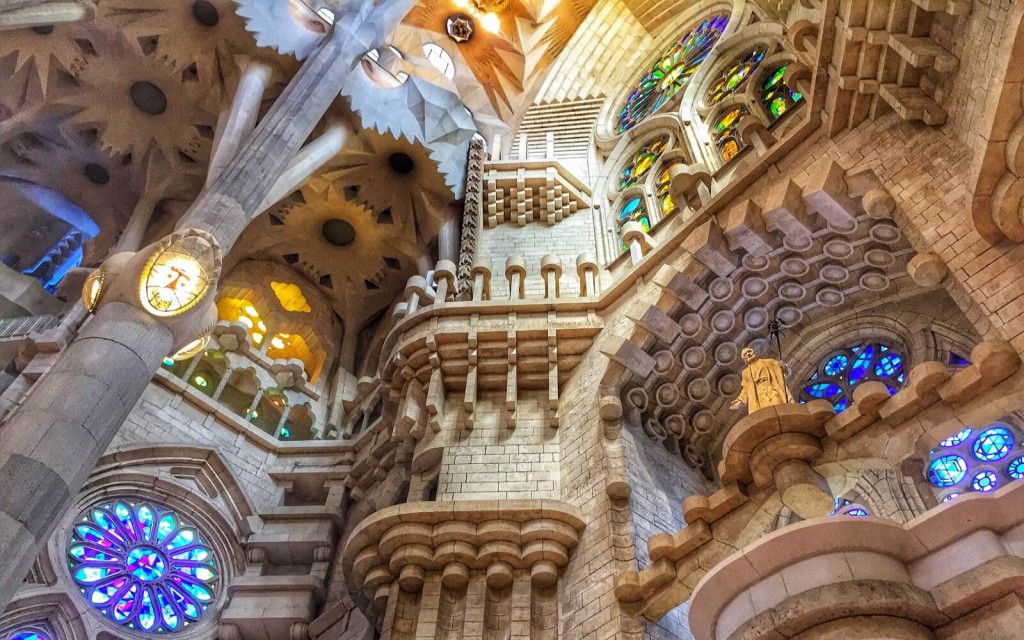
Geometric details
The steeples on the Nativity façade are crowned with geometrically shaped tops that are reminiscent of Cubism (they were finished around 1930), and the intricate decoration is contemporary to the style of Art Nouveau, but Gaudí’s unique style drew primarily from nature, not other artists or architects, and resists categorization.
Gaudí used hyperboloid structures in later designs of the Sagrada Família (more obviously after 1914), however there are a few places on the nativity façade—a design not equated with Gaudí’s ruled-surface design—where the hyperboloid crops up. For example, all around the scene with the pelican there are numerous examples (including the basket held by one of the figures). There is a hyperboloid adding structural stability to the cypress tree (by connecting it to the bridge). And finally, the “bishop’s mitre” spires are capped with hyperboloid structures. In his later designs, ruled surfaces are prominent in the nave’s vaults and windows and the surfaces of the Passion façade.
Symbolism
Themes throughout the decoration include words from the liturgy. The steeples are decorated with words such as “Hosanna”, “Excelsis”, and “Sanctus”; the great doors of the Passion façade reproduce excerpts of the Passion of Jesus from the New Testament in various languages, mainly Catalan; and the Glory façade is to be decorated with the words from the Apostles’ Creed, while its main door reproduce the entire Lord’s Prayer in Catalan, surrounded by multiple variations of “Give us this day our daily bread” in other languages. The three entrances symbolize the three virtues: Faith, Hope and Love. Each of them is also dedicated to a part of Christ’s life. The Nativity Façade is dedicated to his birth; it also has a cypress tree which symbolizes the tree of life. The Glory façade is dedicated to his glory period. The Passion façade is symbolic of his suffering. The apse steeple bears Latin text of Hail Mary. All in all, the Sagrada Família is symbolic of the lifetime of Christ.
Areas of the sanctuary will be designated to represent various concepts, such as saints, virtues and sins, and secular concepts such as regions, presumably with decoration to match.
幾何細節
耶穌誕生立面上的尖頂上飾有幾何形狀的頂部,讓人想起立體主義(它們於1930年左右完成),複雜的裝飾與新藝術風格同時呈現,但高迪的獨特風格主要來自大自然,而不是其他藝術家或建築師,並抵制分類。
高迪在SagradaFamília的後期設計中使用了雙曲面結構(更明顯是在1914年之後),然而在耶穌誕生的外立面上有一些地方 – 一種設計不等於高迪的統治表面設計 – 雙曲面出現的地方。例如,鵜鶘周圍的場景中有很多例子(包括其中一個圖所持有的籃子)。有一種雙曲面增加了柏樹的結構穩定性(通過將其連接到橋上)。最後,“主教的主教”尖頂上有雙曲面結構。在他後來的設計中,規則表面在中殿的拱頂和窗戶以及Passion外牆的表面上都很突出。
象徵
整個裝飾的主題包括禮拜儀式。尖塔上裝飾著諸如“Hosanna”,“Excelsis”和“Sanctus”等字樣; Passionfaçade的大門以各種語言(主要是加泰羅尼亞語)再現了新約中耶穌受難的摘錄;榮耀的外觀將用來自使徒信經的文字進行裝飾,而其主門則以加泰羅尼亞語重現整個主禱文,其中包括多種“以今日為我們的日常麵包”的其他語言。三個入口象徵著三個美德:信仰,希望和愛。他們每個人也致力於基督生活的一部分。耶穌誕生的外牆致力於他的誕生;它還有一棵柏樹,象徵著生命之樹。榮耀的外觀致力於他的輝煌時期。 Passionfaçade象徵著他的痛苦。後殿尖頂帶有Hail Mary的拉丁文。總而言之,聖家堂(SagradaFamília)象徵著基督的一生。
聖所的區域將被指定代表各種概念,例如聖徒,美德和罪惡,以及諸如地區之類的世俗概念,可能與裝飾相匹配。
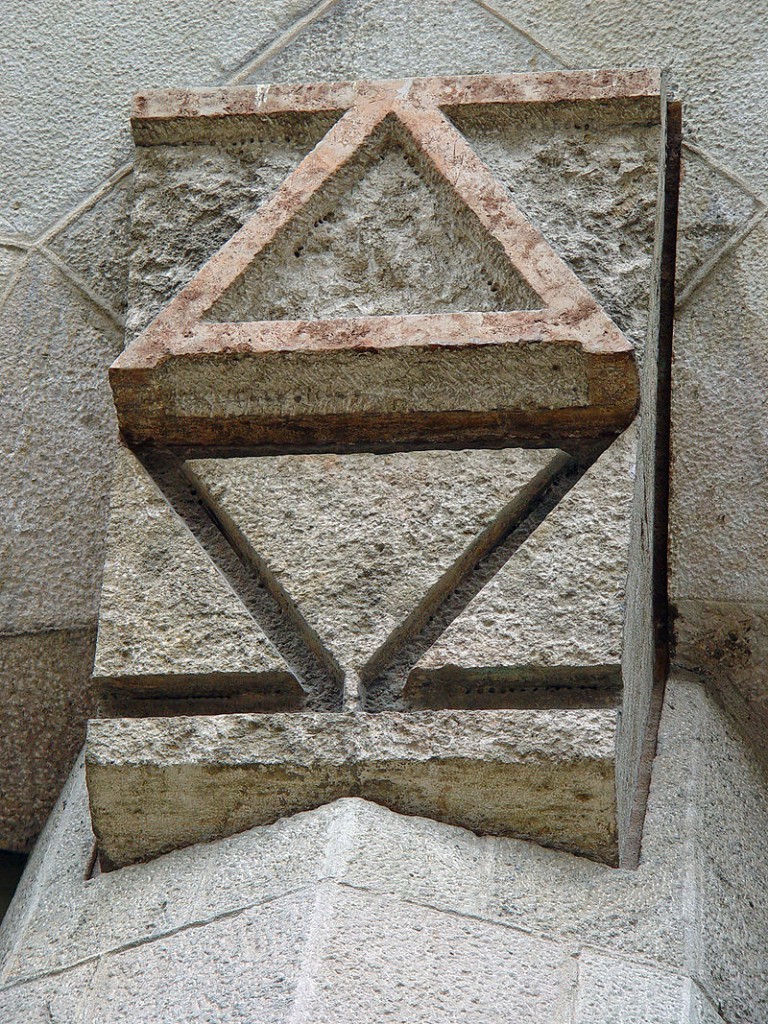
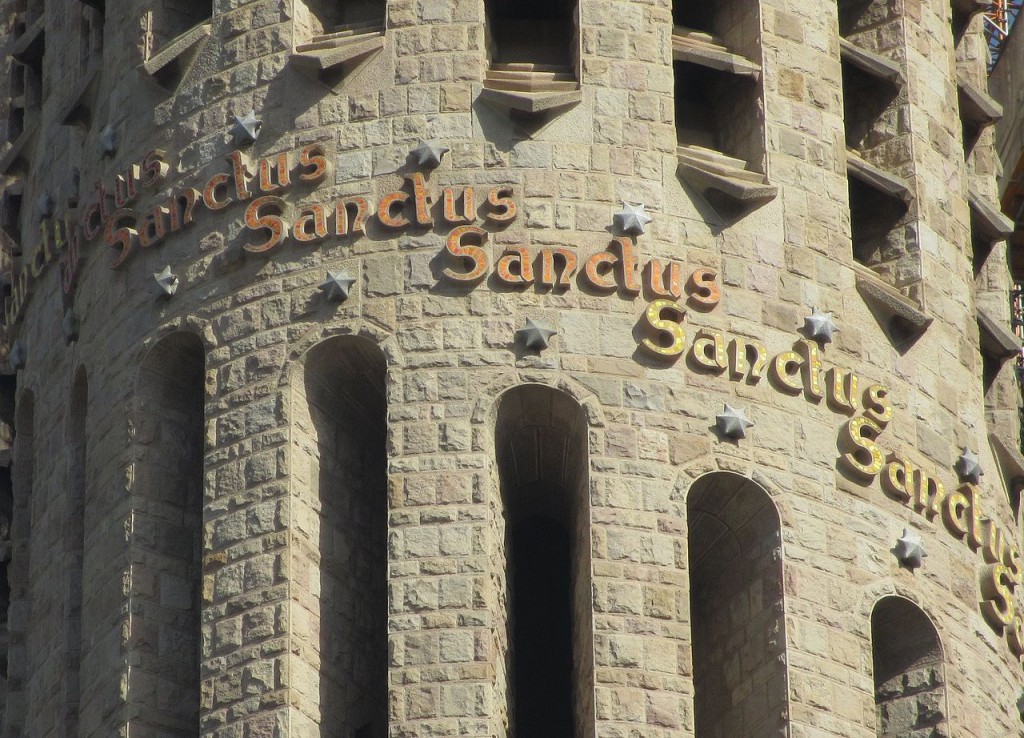
FROM:https://en.wikipedia.org/wiki/Sagrada_Fam%C3%ADlia
FROM:Sagrada Familia Visualisation of the Finished Basilica
FROM:SAGRADA FAMILIA – BARCELONA SPAIN HD
FROM:La Sagrada Familia a Barcelone
Don’t you think it’s addictive?
Want to know more about the beauty of architecture?
Come and join our members to explore the beauty of architectural design.
覺得看得不過癮嗎?
想要知道更多建築之美嗎?
快來加入我們的會員,一同探索建築設計之美。
The above article is purely for appreciation and sharing purposes, as well as the construction of new technology and the public can be in-depth understanding of the information at the same time there are sources, will be able to query, no use of the document as a commercial transaction, if illegal, please inform the We will immediately remove the site, thank you for cooperation.
以上文章純粹作為欣賞及分享用途,以及將建築新型技術傳遞給與大眾能夠深入了解,同時資料還有來源,將可查詢,絕無使用該文件資料作為商業交易行為,如有違法請務必告知該網站我們將立即處理撤除,謝謝合作。

